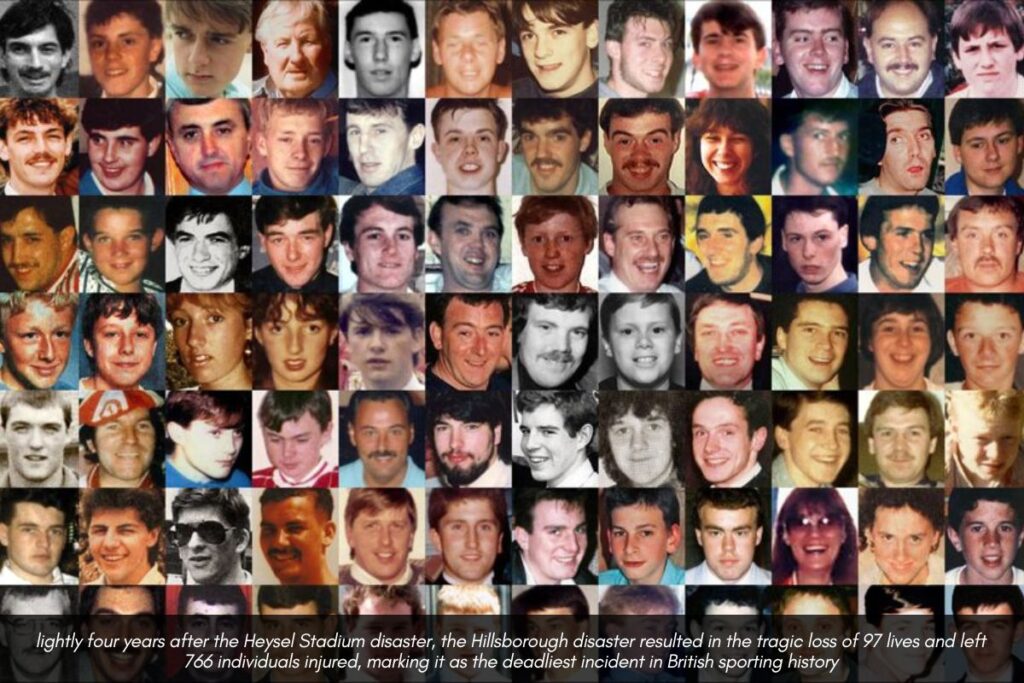The Hillsborough disaster, a tragic event in football history, unfolded during an FA Cup semi-final between Liverpool and Nottingham Forest on April 15, 1989, resulting in many fatalities and hundreds of injuries, making it the deadliest incident in British sporting history. The aftermath saw Liverpool FC, under Kenny Dalglish, and the wider football community grappling with its ramifications. In this article, we’ll delve into the events of that fateful day, the subsequent investigations, and the lasting legacy of football safety and justice.
Why Did the Hillsborough Disaster Happen?
Hillsborough Stadium, home to Sheffield Wednesday, was chosen as the venue for the FA Cup semi-final between Liverpool and Nottingham Forest. At the time, most English football stadiums had high steel fencing between spectators and the playing field due to concerns about hooliganism and pitch invasions. However, this measure also posed risks in terms of crowd control and safety.
The Leppings Lane end of Hillsborough Stadium, where the disaster occurred, had not been updated since 1979 and lacked a valid safety certificate. Previous incidents, including a crush during the 1981 FA Cup semi-final between Tottenham Hotspur and Wolverhampton Wanderers, had highlighted the dangers of overcrowding. Despite recommendations for capacity reduction, Sheffield Wednesday made alterations to the layout instead, dividing the terrace into three separate pens. Similar overcrowding incidents were observed in subsequent years, including during the 1987 and 1988 FA Cup semi-finals. Complaints from fans, particularly from Liverpool supporters, raised concerns about safety at the Leppings Lane end.
Changes in the South Yorkshire Police (SYP) command structure also played a role in the lead-up to the Hillsborough disaster. Chief Superintendent Brian L. Mole, who had overseen previous police deployments at Hillsborough, was transferred to another division in October 1988. This transfer left planning for the upcoming semi-final in the hands of Chief Superintendent David Duckenfield, who lacked experience commanding sell-out football matches and had limited training in crowd control.
The absence of Mole, coupled with Duckenfield’s inexperience, created a gap in leadership and decision-making for the match. Despite warnings and concerns raised in previous years, adequate measures were not taken to address safety issues at Hillsborough Stadium. These factors set the stage for the tragic events that unfolded on April 15, 1989, highlighting the need for changes not only in stadium safety protocols but also in the management and command structure of police operations during major sporting events.
Fans Who Died in the Hillsborough Disaster
Slightly four years after the Heysel Stadium disaster, the Hillsborough disaster resulted in the tragic loss of 97 lives and left 766 individuals injured, marking it as the deadliest incident in British sporting history. In the aftermath, a disaster appeal fund was swiftly established, with contributions pouring in from various sources, including the UK Government, Liverpool FC, and the cities of Liverpool, Sheffield, and Nottingham. The total donations surpassed £1 million within days and ultimately exceeded £12 million by the time the appeal closed in 1990.

The impact on the survivors and families of the victims was profound. Many faced physical injuries, trauma, and the loss of loved ones, while others endured ongoing emotional and psychological challenges. The support provided by the disaster appeal fund offered crucial assistance to those affected, providing financial aid, medical care, and other forms of support during their recovery process.
Additionally, the wider football community rallied together in solidarity and support, with gestures of sympathy and commemoration observed across the country. Charity events, benefit concerts, and fundraising matches were organized to contribute to the relief efforts and honor the memory of those who had perished in the tragedy. The disaster left an indelible mark on the collective consciousness, prompting reflection, reform, and a renewed commitment to ensuring the safety and well-being of football fans nationwide.
Further Statistics Explained
The Hillsborough disaster resulted in the tragic loss of lives and individuals injured, with the majority of deaths attributed to injuries sustained during the crash. Among the victims were 7 women and 90 men, ranging in age from 10 to 67 years old. The ages of those who perished illustrate the diverse demographics affected by the tragedy, with 38 individuals between the ages of 10 and 19, and 41 individuals between the ages of 20 and 29. The impact was particularly devastating for young people, with 79 victims aged under 30, and 38 of them under the age of 20.
The loss of life extended beyond mere statistics, as families and communities mourned the untimely deaths of loved ones. The tragic circumstances surrounding the Hillsborough disaster, compounded by the prolonged legal battles and emotional trauma endured by survivors and families, underscored the profound human toll of the events at Hillsborough Stadium. The aftermath of the disaster prompted widespread soul-searching and calls for accountability, as authorities and institutions faced scrutiny over their roles in ensuring the safety and well-being of football fans. The Hillsborough tragedy remains a poignant reminder of the importance of vigilance, accountability, and continual efforts to prioritize the safety of supporters in all sporting events.
Taylor’s Report of 1990
The Taylor Inquiry, led by Lord Justice Taylor, was established to investigate the Hillsborough disaster and its underlying causes. Conducted over 31 days between May and June 1989, the inquiry produced two significant reports: an interim report in August 1989 and a final report in January 1990. Together, these documents formed the Taylor Report, which became pivotal in understanding the events of the tragedy and recommending measures for improving football ground safety.

Lord Taylor’s findings placed significant responsibility on the policing operation on the day of the Hillsborough disaster, citing a breakdown in control as the primary reason for the tragic events. He criticized the decision to open secondary gates and highlighted the failure to delay the kick-off despite mounting congestion at the venue. Additionally, the Taylor Report identified shortcomings in the infrastructure and management of Hillsborough Stadium, particularly regarding inadequate turnstiles and poor-quality crush barriers. Sheffield Wednesday Football Club, as the stadium owner, faced criticism for these deficiencies.
The report also addressed misconceptions about the behavior of Liverpool fans, refuting claims of widespread drunkenness and dismissing theories of ticketless or forged ticket entries contributing to the disaster. Instead, Lord Taylor emphasized systemic failures in police control and stadium management as the root causes.
Hillsborough Disaster Investigations and Prosecution
The aftermath of the Hillsborough disaster saw a series of criminal and civil cases unfold. In 2000, Chief Superintendent David Duckenfield and another officer, Bernard Murray, faced a private prosecution, with Duckenfield accused of gross negligence in opening the gates. However, the jury was unable to reach a verdict, and subsequent police disciplinary charges were abandoned.
In 2017, six individuals, including Duckenfield, faced various charges related to the Hillsborough disaster, such as manslaughter by gross negligence and perverting the course of justice. While some were acquitted, Duckenfield faced a retrial but was ultimately found not guilty of gross negligence manslaughter in 2019. Civil litigation included cases brought against the police for negligence, with significant legal landmarks reached, such as the Alcock and White cases concerning claims of psychiatric injury. Additionally, the case of Airedale N.H.S. Trust v Bland addressed legal issues surrounding the withdrawal of life support.
Conclusion
The Hillsborough disaster of 1989 underscored the critical importance of effective crowd control and emergency response measures. The Taylor Report, born from a comprehensive inquiry, highlighted significant shortcomings in police management and stadium infrastructure, particularly the decision to open secondary gates without adequate crowd control measures. Recommendations from the report emphasized the need for improved planning, coordination among law enforcement agencies, and enhanced stadium safety standards. Transparent accountability mechanisms were also stressed, urging thorough investigations and legal proceedings to ensure justice for the victims and their families.
Remedial measures proposed included stricter safety protocols, policing reforms, public awareness campaigns, and continuous review of safety regulations. By heeding these recommendations and implementing proactive measures, society can strive to prevent similar tragedies and honor the memory of the Hillsborough disaster victims.
Read all other posts on the Hillsborough Disaster
Find the Latest News on Player Ratings | Transfers | Prematch | Postmatch
Stay tuned for more updates on Liverpool FC Times and Stories. Your thoughts are always welcome in the comments section. Thank you for your continued support!
YNWA (You’ll Never Walk Alone)!
The Liverpool FC Times Team
LiverpoolFCTimes.com
